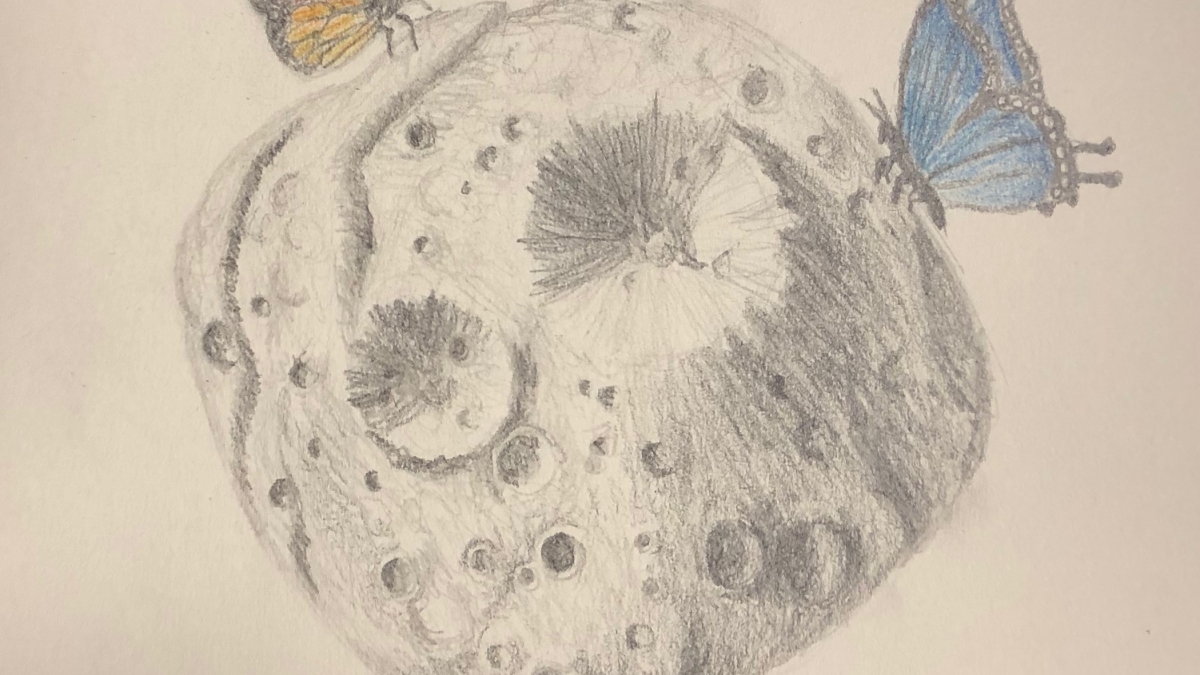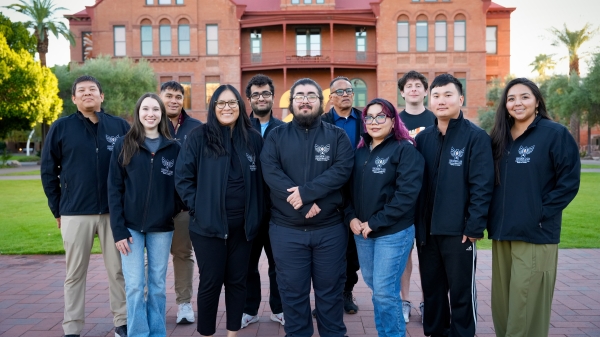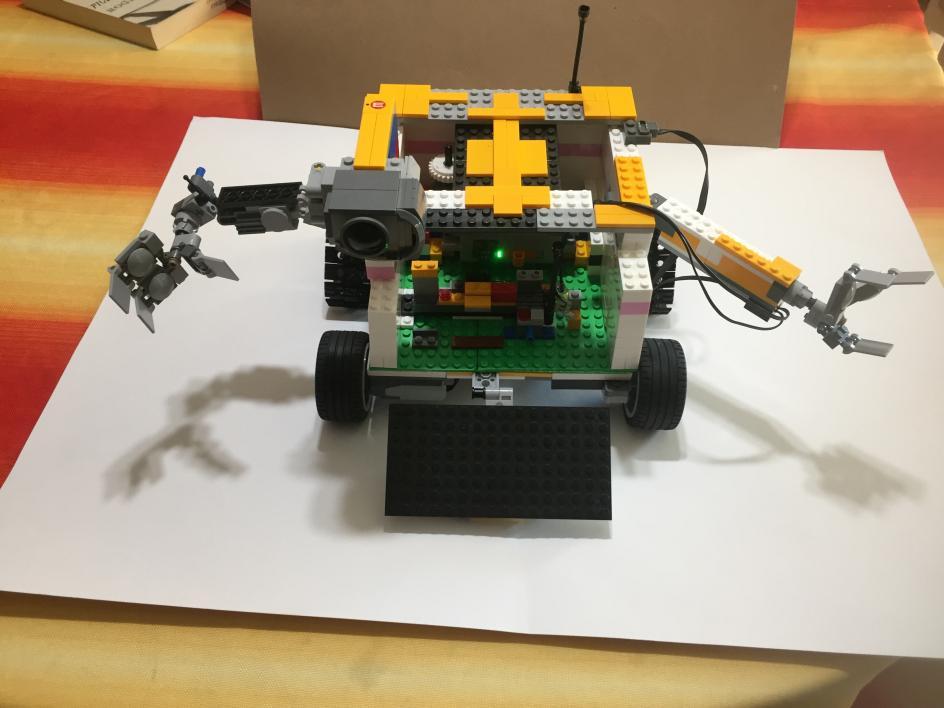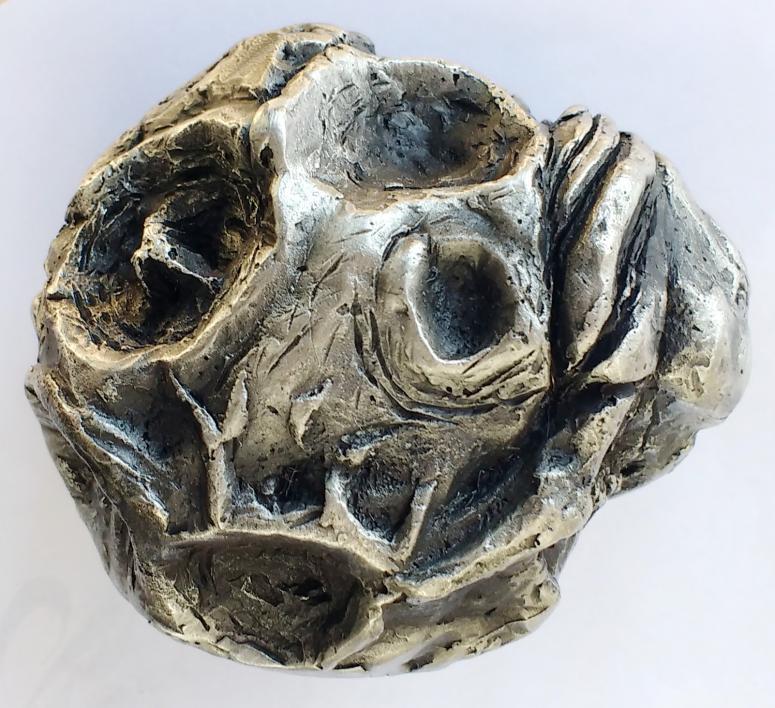ASU-led NASA Psyche Mission invites the public to be ‘spacecrafty’

A #PsycheSpaceCRAFTY submission in colored pencil from Psyche Mission program scientist Sarah Noble, who was inspired by the mission’s name, Psyche, which is the Greek word for “soul” and also sometimes “butterfly.”
The ASU-led NASA Psyche Mission, a journey to a unique metal world, has been inspiring professional and amateur artists since the announcement of the mission’s selection by NASA in early 2017.
Since then, dozens of pieces of original art, inspired by the mission, have been posted by artists on social media and shared with the mission’s principal investigator, Lindy Elkins-Tanton. Works have included oil paintings and drawings of what the Psyche asteroid might look like, stickers designed with the Greek goddess Psyche on them, and even magic wands made of iron, with filings from iron meteorites in the tip, like the phoenix feather inside famous wizard Harry Potter's wand.
“People from all over the world have shared images of art they have created, inspired by the Psyche mission,” Elkins-Tanton said. “The connection and communication between the artists, myself and the Psyche team feels deeply human and exactly the kind of inspiration, curiosity and creation we hope that space exploration engenders.”
In response to this public interest, the Psyche Mission team has created a formal platform, dubbed #PsycheSpaceCRAFTY, where the public can share their mission-inspired creations on the Psyche Mission website. The program is available to everyone with an interest in submitting an artistic piece, inspired by the mission, that can be shared online.
“We believe that science and art complement each other,” said Cassie Bowman, Psyche mission co-investigator. “Whatever their interests or training, we invite the public to share with us how they’ve been inspired by our journey to a metal world.”
How to submit an artistic work to #PsycheSpaceCRAFTY
To get started, participants are encouraged to learn about the people, science, innovation and goals of the mission and what it might mean to the artists and their community.
Participants can then submit their creation using the #PsycheSpaceCRAFTY online form.
Creations can be in any medium that can be shared online, including drawings, songs, stories, sculptures, dance, paintings, poems, crafts and other artistic expressions. Participants may also want to look at the artwork that has been created by the Psyche Inspired artists, a formal national program for undergraduate student artists.
Psyche team members and their families have already begun to participate and share their creative works with #PsycheSpaceCRAFTY, like Sarah Noble, the mission’s program scientist who has contributed several works in colored pencil and watercolor and ink. “Art and science are both forms of creative problem solving, and creative problem solving is the heart and soul of any space mission,” Noble said.
‘Psyche Inspired’ national program for undergraduates
In addition to the newly launched #PsycheSpaceCRAFTY program, U.S. undergraduate students may also be interested in applying for the formal NASA Psyche mission “Psyche Inspired” program, led by ASU. Through this program, undergraduate students from any discipline or major can share the excitement, innovation, and scientific and engineering content of NASA’s Psyche mission with the public in new ways through artistic and creative works. The application for next academic year’s class will be available in late summer 2019. Interested students are encouraged to check back on the website for more information and the application.
The Psyche Mission
Psyche, an asteroid orbiting the sun between Mars and Jupiter, is made almost entirely of nickel-iron metal. As such, it offers a unique look into the violent collisions that created Earth and the terrestrial planets.
The Psyche spacecraft is planned to launch in August 2022 and travel to the asteroid using solar-electric (low thrust) propulsion. After flying by Mars in 2023 for a gravity assist, the spacecraft will arrive at Psyche in 2026 and spend 21 months orbiting the asteroid, mapping it and studying its properties.
The scientific goals of the Psyche mission are to understand the building blocks of planet formation and explore firsthand a wholly new and unexplored type of world. The mission team seeks to determine whether Psyche is the core of an early planet, how old it is, whether it formed in similar ways to the Earth's core, and what its surface is like.
The spacecraft's instrument payload will include a magnetometer, a multispectral imager and a gamma ray and neutron spectrometer. The mission will also test a sophisticated new laser communications technology, called Deep Space Optical Communications (DSOC).
The Psyche Mission is part of NASA's Discovery Program. Psyche Principal Investigator Lindy Elkins-Tanton is the director of ASU’s School of Earth and Space Exploration. Other ASU researchers on the Psyche mission team include Jim Bell (deputy principal investigator and co-investigator), David Williams (co-investigator) and Catherine Bowman (co-investigator and student collaborations lead).
The mission is led by Arizona State University. NASA’s Jet Propulsion Laboratory is responsible for the mission’s overall management, system engineering, integration and test, and mission operations. Maxar Space Solutions, formerly Space Systems Loral, is providing a high-power solar electric propulsion spacecraft chassis.
More Science and technology

Indigenous geneticists build unprecedented research community at ASU
When Krystal Tsosie (Diné) was an undergraduate at Arizona State University, there were no Indigenous faculty she could look to…

Pioneering professor of cultural evolution pens essays for leading academic journals
When Robert Boyd wrote his 1985 book “Culture and the Evolutionary Process,” cultural evolution was not considered a true…

Lucy's lasting legacy: Donald Johanson reflects on the discovery of a lifetime
Fifty years ago, in the dusty hills of Hadar, Ethiopia, a young paleoanthropologist, Donald Johanson, discovered what would…


